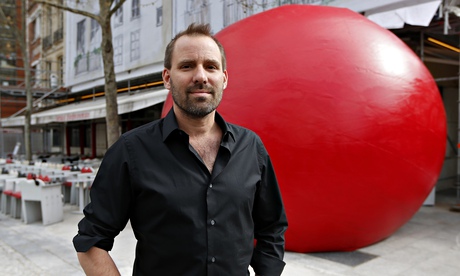
A New York artist who has been placing giant red balls around cities for 13 years has accused the oil company Shell of using his idea for its latest billboard campaign.
Kurt Perschke’s RedBall Project has toured cities around the world, including London in 2012. It is a simple concept: he makes temporary sculptural interventions by placing 15ft red balls in unexpected places, whether on bridges, in public squares or squeezed between buildings.
Shell’s new poster campaign also uses big red balls in unexpected places, and the Brooklyn-based artist has accused the company of appropriating his idea.
“It’s painful,” he said. “There isn’t any doubt in my mind. Even though it might seem that a ball would be a ball would be ball, [my] red ball is specific in the way it is constructed and built and these graphics that they have created are spot on.”
Perschke created the red ball project in 2001 and has taken it to more than 20 cities, including this year Montreal, Rennes and Galway. Next year it will go to Singapore and, Perschke hopes, to Wales. When it came to London as part of the Cultural Olympiad, the balls appeared on the Millennium and Jubilee bridges over the Thames.
“The piece is about playing with the architecture of the city,” said Perschke. “It is about imagining what can happen in a city, it is about playing.”
Last week Perschke was alerted to the Shell billboard poster campaign which uses even bigger red balls. One is pictured behind Nelson’s Column in Trafalgar Square, and another next to the Forth bridge in Scotland. They come with the tagline: “Imagine capturing this much CO2 every day.”
Shell denied it was using Perschke’s concept. “This Shell campaign uses red spheres as a visual device to illustrate the volume of CO2 that the Peterhead CCS project is designed to capture each day. It is intended to help consumers understand through a simple visual representation the importance of capturing CO2 for a better energy future,” a spokesperson said.
“The campaign uses imagined illustrations of a red sphere in iconic locations. They are not actual or physical installations of red balls, which is the focus of the artist’s installations.”
Shell said it was not unusual to visualise carbon emissions spherically. For example, the New York company Carbon Visuals, which specialises in visualising greenhouse gases, has created graphics that use turquoise balls to show just how much gas is being pumped out in to the atmosphere.
Despite the denials, Perschke is adamant that his creation has been appropriated without his permission. “They could have done it a lot of ways, it could have been a balloon or a kickball or a football or whatever but it’s not, it’s spot on and because we were in London so recently it is frustrating and disheartening.
“Someone could have picked up the phone and talked to me. It is unfortunate because they have taken the visual impact of the project. If next year I’m in Wales it’s important to me that someone isn’t thinking of Shell. I don’t demonise advertising agencies but no one likes being ripped off by a mega corporation.”
Last year Perschke won a legal case against the French company Edenred, which also used big red balls in its advertising. “It was settled in a way that respects my copyright,” he said. “The case is public, the settlement is not.”
The artist said he had not yet decided whether he would try to take on Shell. “It is my creation. I think it is lazy. My work has a history, it has been around for years and to appropriate it maybe seems more than lazy – even a little dangerous. The larger issue is the impact on the work, I don’t want the work impacted or associated in this way. We’ve worked for many years on a project which really does bring joy and surprise to people and we don’t want it co-opted.”

